Australian NBFIs: Deregulation, Royal Commission, and Future Trends
VerifiedAdded on 2022/11/28
|11
|3537
|108
Report
AI Summary
This report assesses the impact of financial sector deregulation on non-bank financial institutions (NBFIs) in Australia, specifically focusing on building societies and credit unions. It examines the decline in the number of these institutions since deregulation, the trend of some restructuring into banks (e.g., Defence Bank and Heritage Bank), and the rationale behind this shift. The report also considers the implications for remaining NBFIs and whether the trend should continue. Furthermore, it reflects on the negative findings of the Royal Commission into Misconduct in the Banking, Superannuation and Financial Services Industry and their relevance to NBFIs. The analysis includes a review of relevant literature discussing the deregulation process and its effects on the financial sector, highlighting increased competition, regulatory changes, and the challenges faced by smaller credit unions. The report concludes with recommendations regarding the future of building societies and credit unions, suggesting whether they should be allowed to continue transforming into banks, and emphasizes the importance of these institutions differentiating themselves through customer service and community engagement.

Banking and finance
Paraphrase This Document
Need a fresh take? Get an instant paraphrase of this document with our AI Paraphraser
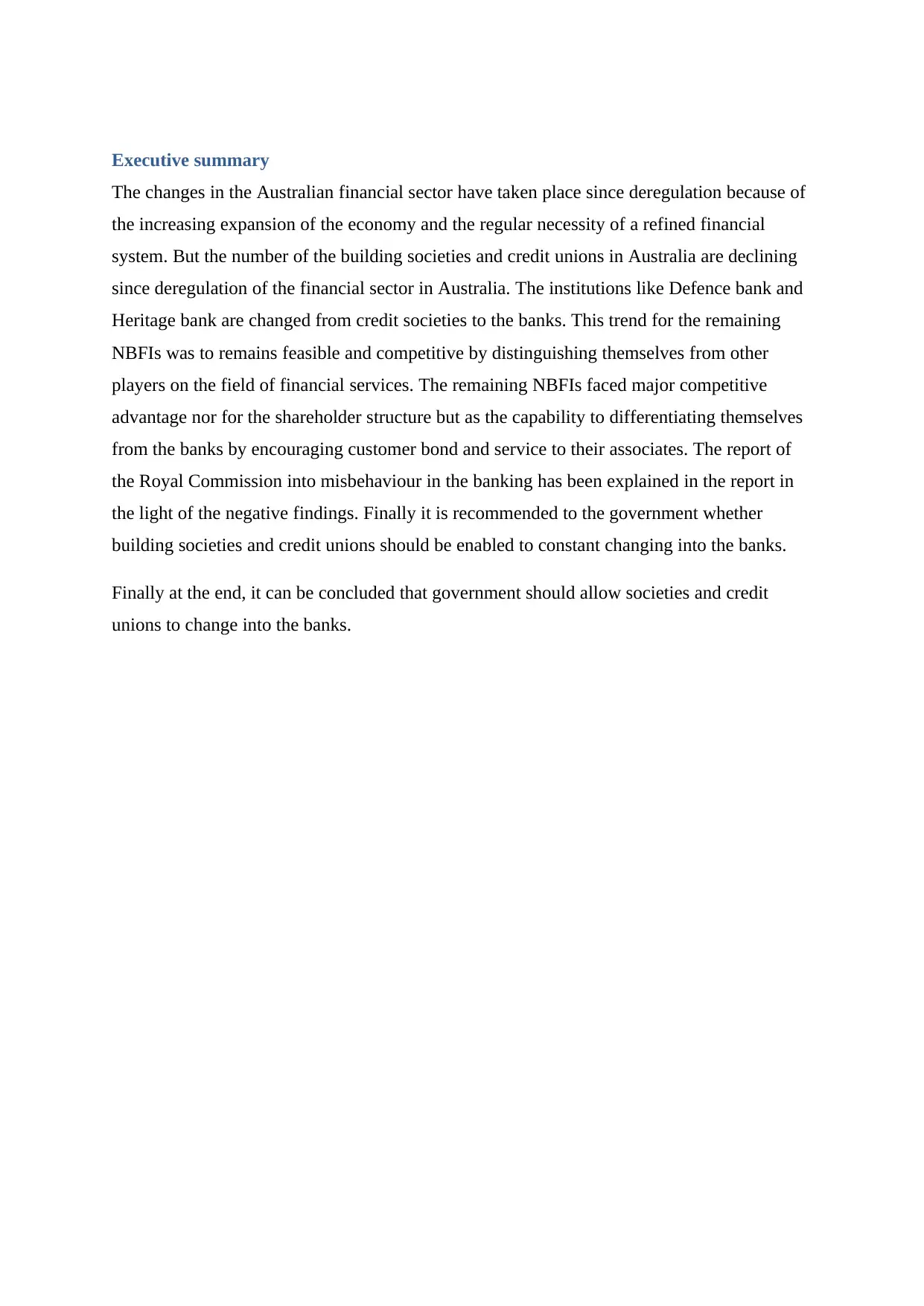
Executive summary
The changes in the Australian financial sector have taken place since deregulation because of
the increasing expansion of the economy and the regular necessity of a refined financial
system. But the number of the building societies and credit unions in Australia are declining
since deregulation of the financial sector in Australia. The institutions like Defence bank and
Heritage bank are changed from credit societies to the banks. This trend for the remaining
NBFIs was to remains feasible and competitive by distinguishing themselves from other
players on the field of financial services. The remaining NBFIs faced major competitive
advantage nor for the shareholder structure but as the capability to differentiating themselves
from the banks by encouraging customer bond and service to their associates. The report of
the Royal Commission into misbehaviour in the banking has been explained in the report in
the light of the negative findings. Finally it is recommended to the government whether
building societies and credit unions should be enabled to constant changing into the banks.
Finally at the end, it can be concluded that government should allow societies and credit
unions to change into the banks.
The changes in the Australian financial sector have taken place since deregulation because of
the increasing expansion of the economy and the regular necessity of a refined financial
system. But the number of the building societies and credit unions in Australia are declining
since deregulation of the financial sector in Australia. The institutions like Defence bank and
Heritage bank are changed from credit societies to the banks. This trend for the remaining
NBFIs was to remains feasible and competitive by distinguishing themselves from other
players on the field of financial services. The remaining NBFIs faced major competitive
advantage nor for the shareholder structure but as the capability to differentiating themselves
from the banks by encouraging customer bond and service to their associates. The report of
the Royal Commission into misbehaviour in the banking has been explained in the report in
the light of the negative findings. Finally it is recommended to the government whether
building societies and credit unions should be enabled to constant changing into the banks.
Finally at the end, it can be concluded that government should allow societies and credit
unions to change into the banks.
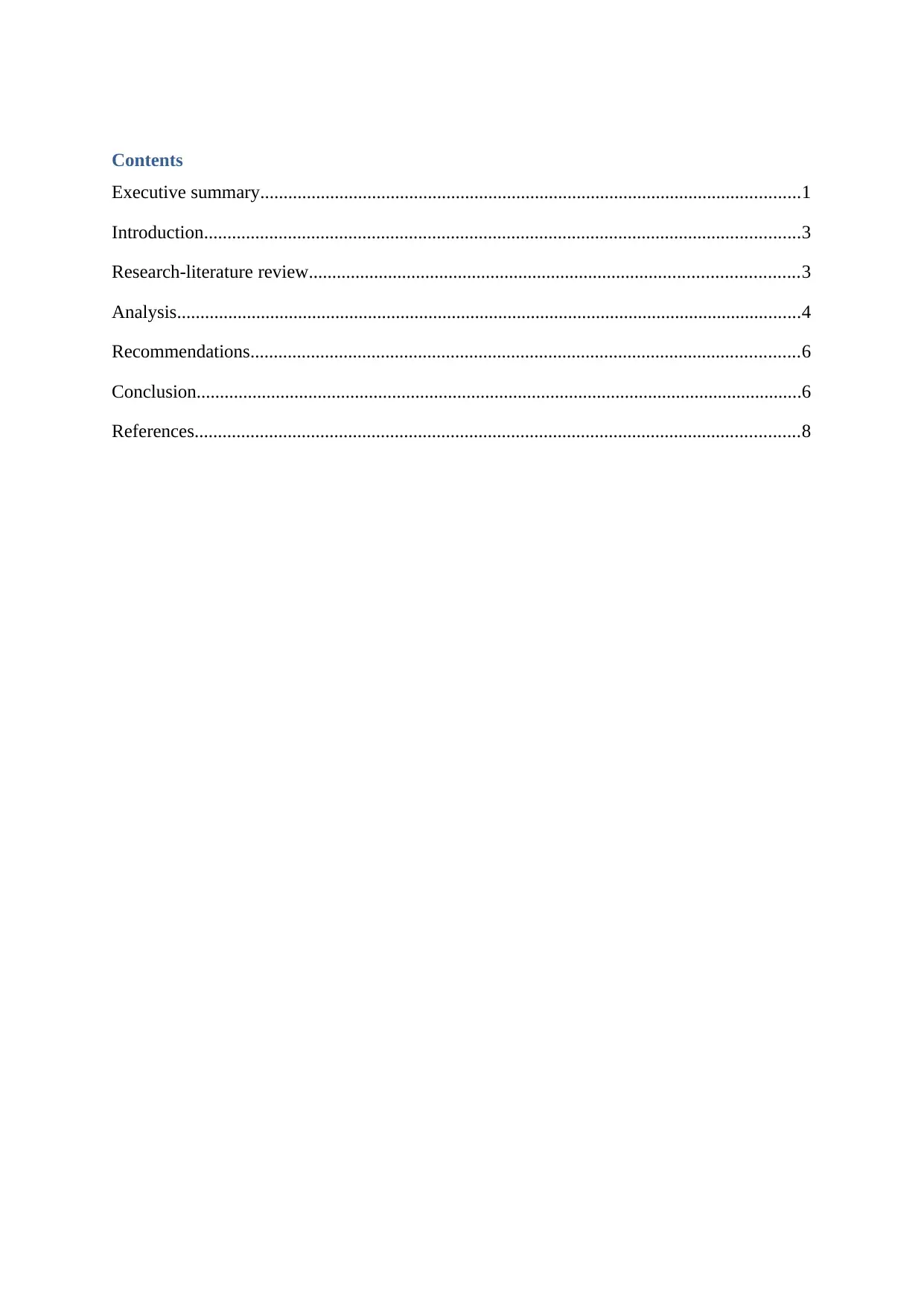
Contents
Executive summary....................................................................................................................1
Introduction................................................................................................................................3
Research-literature review.........................................................................................................3
Analysis......................................................................................................................................4
Recommendations......................................................................................................................6
Conclusion..................................................................................................................................6
References..................................................................................................................................8
Executive summary....................................................................................................................1
Introduction................................................................................................................................3
Research-literature review.........................................................................................................3
Analysis......................................................................................................................................4
Recommendations......................................................................................................................6
Conclusion..................................................................................................................................6
References..................................................................................................................................8
⊘ This is a preview!⊘
Do you want full access?
Subscribe today to unlock all pages.

Trusted by 1+ million students worldwide

Introduction
The non-banking financial institutions (NBFI) in Australia comprise societies, credit unions
and finance companies. The non-banking financial sector is aimed at providing banking
services where public cannot reach to the banks, also in the areas where this service never
exist. The non-banking financial institutions are the financial institutions which do not have
complete banking license and are not in the condition of accepting credits from the public.
But such institutions enable substitute financial services like investment, financial accessing,
money diffusion, brokering and check cashing. The NBFI are the source of consumer credit.
NBFI covers venture capitalists, insurance firms, currency connections, microloan
organizations and pawn shops.
Prior to the period of 1980s, the banks were regulated for the types of the products they were
enabled to offer and the prices they were permitted to charge. The NBFI were less heavily
regulated and were growing number of the shares at the expense of the banks. Several
legislative and economic events took place in the early 1980s as post deregulation of the
Australian financial sector took place.
The financial sector deregulation in Australia in the 1990s treated credit unions and building
societies the same as the banks. It enabled credit unions to choose between various
organizational structures like cooperative, customer owned banks or demutualize. The
number of the societies and credit unions are progressively declining after the deregulation of
the Australian financial sector.
Research-literature review
According to the Berg, 2016, the financial system of the Australia was extremely regulated
between World war ll and late 1970s. The controls made over various aspect of the finance
through parameter of the amount, form and assessing of the banking services, an
accomplished exchange rate system and ruling of the foreign exchange and foreign bank
entry. The policy was majorly redirected from the early 1980s which led to the deregulation
of the financial system. The formation of the inquiry patents the beginning of the thoughtful
program which intended at the inclusive financial reform. It offered a reliable case for the
The non-banking financial institutions (NBFI) in Australia comprise societies, credit unions
and finance companies. The non-banking financial sector is aimed at providing banking
services where public cannot reach to the banks, also in the areas where this service never
exist. The non-banking financial institutions are the financial institutions which do not have
complete banking license and are not in the condition of accepting credits from the public.
But such institutions enable substitute financial services like investment, financial accessing,
money diffusion, brokering and check cashing. The NBFI are the source of consumer credit.
NBFI covers venture capitalists, insurance firms, currency connections, microloan
organizations and pawn shops.
Prior to the period of 1980s, the banks were regulated for the types of the products they were
enabled to offer and the prices they were permitted to charge. The NBFI were less heavily
regulated and were growing number of the shares at the expense of the banks. Several
legislative and economic events took place in the early 1980s as post deregulation of the
Australian financial sector took place.
The financial sector deregulation in Australia in the 1990s treated credit unions and building
societies the same as the banks. It enabled credit unions to choose between various
organizational structures like cooperative, customer owned banks or demutualize. The
number of the societies and credit unions are progressively declining after the deregulation of
the Australian financial sector.
Research-literature review
According to the Berg, 2016, the financial system of the Australia was extremely regulated
between World war ll and late 1970s. The controls made over various aspect of the finance
through parameter of the amount, form and assessing of the banking services, an
accomplished exchange rate system and ruling of the foreign exchange and foreign bank
entry. The policy was majorly redirected from the early 1980s which led to the deregulation
of the financial system. The formation of the inquiry patents the beginning of the thoughtful
program which intended at the inclusive financial reform. It offered a reliable case for the
Paraphrase This Document
Need a fresh take? Get an instant paraphrase of this document with our AI Paraphraser
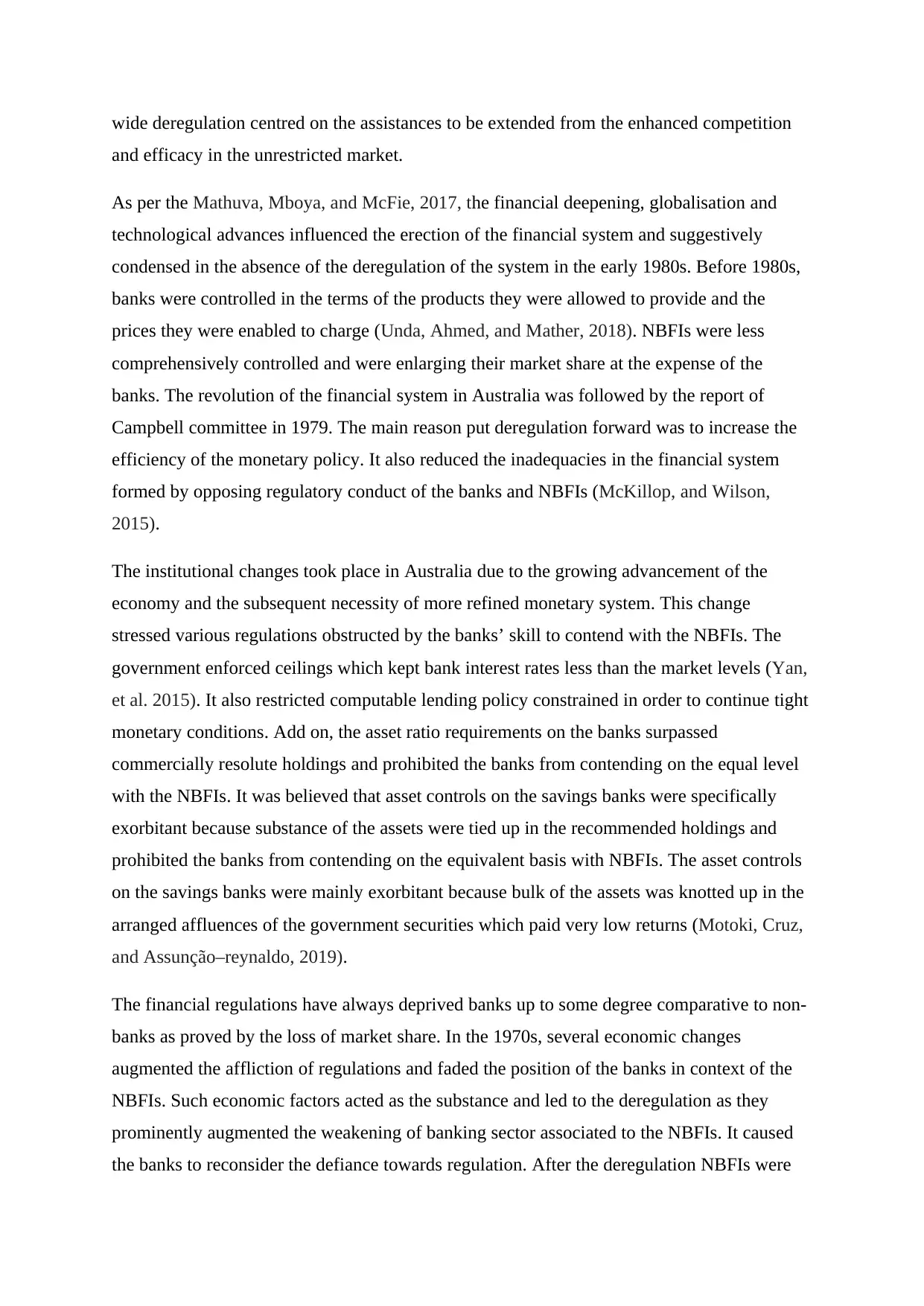
wide deregulation centred on the assistances to be extended from the enhanced competition
and efficacy in the unrestricted market.
As per the Mathuva, Mboya, and McFie, 2017, the financial deepening, globalisation and
technological advances influenced the erection of the financial system and suggestively
condensed in the absence of the deregulation of the system in the early 1980s. Before 1980s,
banks were controlled in the terms of the products they were allowed to provide and the
prices they were enabled to charge (Unda, Ahmed, and Mather, 2018). NBFIs were less
comprehensively controlled and were enlarging their market share at the expense of the
banks. The revolution of the financial system in Australia was followed by the report of
Campbell committee in 1979. The main reason put deregulation forward was to increase the
efficiency of the monetary policy. It also reduced the inadequacies in the financial system
formed by opposing regulatory conduct of the banks and NBFIs (McKillop, and Wilson,
2015).
The institutional changes took place in Australia due to the growing advancement of the
economy and the subsequent necessity of more refined monetary system. This change
stressed various regulations obstructed by the banks’ skill to contend with the NBFIs. The
government enforced ceilings which kept bank interest rates less than the market levels (Yan,
et al. 2015). It also restricted computable lending policy constrained in order to continue tight
monetary conditions. Add on, the asset ratio requirements on the banks surpassed
commercially resolute holdings and prohibited the banks from contending on the equal level
with the NBFIs. It was believed that asset controls on the savings banks were specifically
exorbitant because substance of the assets were tied up in the recommended holdings and
prohibited the banks from contending on the equivalent basis with NBFIs. The asset controls
on the savings banks were mainly exorbitant because bulk of the assets was knotted up in the
arranged affluences of the government securities which paid very low returns (Motoki, Cruz,
and Assunção–reynaldo, 2019).
The financial regulations have always deprived banks up to some degree comparative to non-
banks as proved by the loss of market share. In the 1970s, several economic changes
augmented the affliction of regulations and faded the position of the banks in context of the
NBFIs. Such economic factors acted as the substance and led to the deregulation as they
prominently augmented the weakening of banking sector associated to the NBFIs. It caused
the banks to reconsider the defiance towards regulation. After the deregulation NBFIs were
and efficacy in the unrestricted market.
As per the Mathuva, Mboya, and McFie, 2017, the financial deepening, globalisation and
technological advances influenced the erection of the financial system and suggestively
condensed in the absence of the deregulation of the system in the early 1980s. Before 1980s,
banks were controlled in the terms of the products they were allowed to provide and the
prices they were enabled to charge (Unda, Ahmed, and Mather, 2018). NBFIs were less
comprehensively controlled and were enlarging their market share at the expense of the
banks. The revolution of the financial system in Australia was followed by the report of
Campbell committee in 1979. The main reason put deregulation forward was to increase the
efficiency of the monetary policy. It also reduced the inadequacies in the financial system
formed by opposing regulatory conduct of the banks and NBFIs (McKillop, and Wilson,
2015).
The institutional changes took place in Australia due to the growing advancement of the
economy and the subsequent necessity of more refined monetary system. This change
stressed various regulations obstructed by the banks’ skill to contend with the NBFIs. The
government enforced ceilings which kept bank interest rates less than the market levels (Yan,
et al. 2015). It also restricted computable lending policy constrained in order to continue tight
monetary conditions. Add on, the asset ratio requirements on the banks surpassed
commercially resolute holdings and prohibited the banks from contending on the equal level
with the NBFIs. It was believed that asset controls on the savings banks were specifically
exorbitant because substance of the assets were tied up in the recommended holdings and
prohibited the banks from contending on the equivalent basis with NBFIs. The asset controls
on the savings banks were mainly exorbitant because bulk of the assets was knotted up in the
arranged affluences of the government securities which paid very low returns (Motoki, Cruz,
and Assunção–reynaldo, 2019).
The financial regulations have always deprived banks up to some degree comparative to non-
banks as proved by the loss of market share. In the 1970s, several economic changes
augmented the affliction of regulations and faded the position of the banks in context of the
NBFIs. Such economic factors acted as the substance and led to the deregulation as they
prominently augmented the weakening of banking sector associated to the NBFIs. It caused
the banks to reconsider the defiance towards regulation. After the deregulation NBFIs were
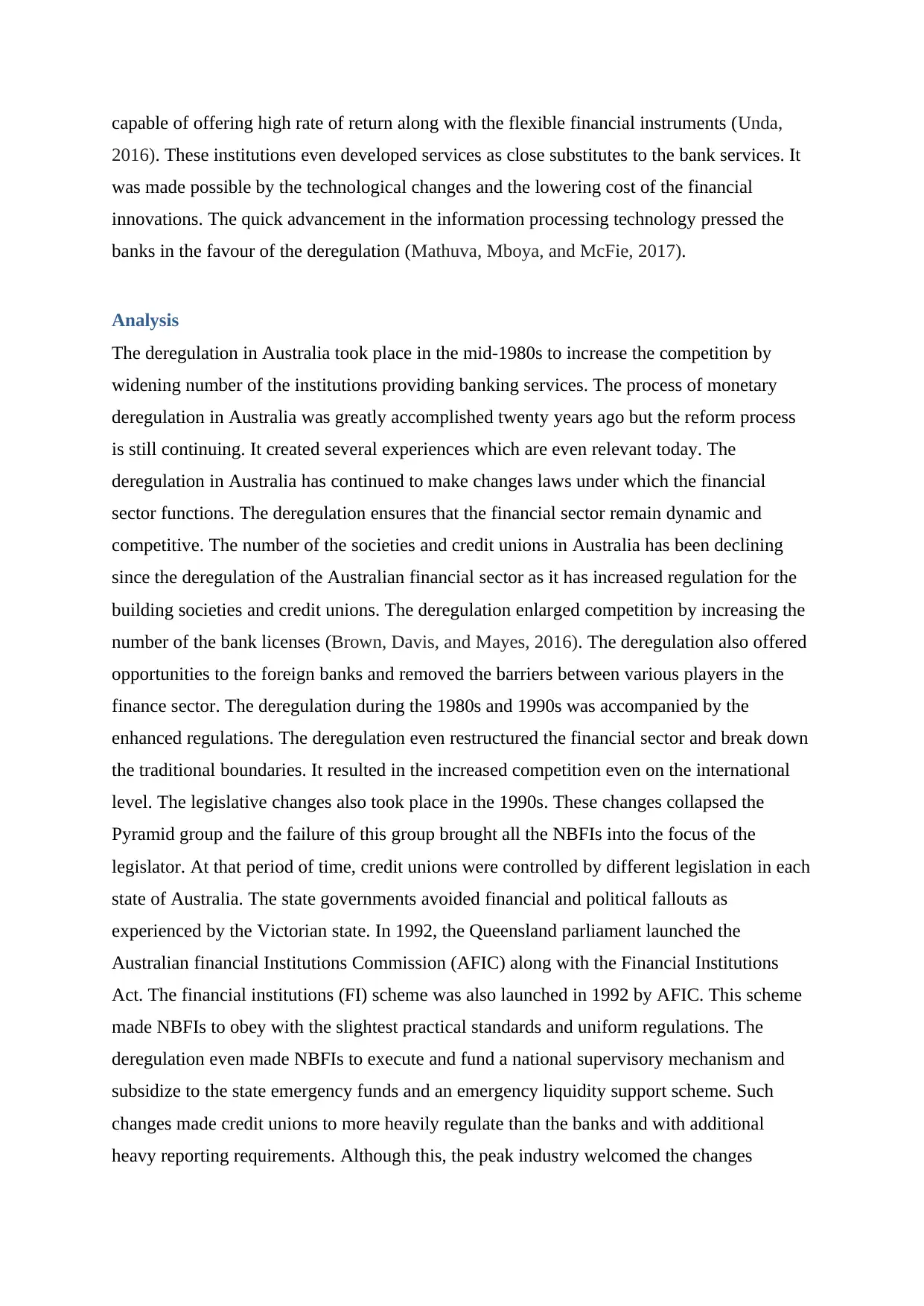
capable of offering high rate of return along with the flexible financial instruments (Unda,
2016). These institutions even developed services as close substitutes to the bank services. It
was made possible by the technological changes and the lowering cost of the financial
innovations. The quick advancement in the information processing technology pressed the
banks in the favour of the deregulation (Mathuva, Mboya, and McFie, 2017).
Analysis
The deregulation in Australia took place in the mid-1980s to increase the competition by
widening number of the institutions providing banking services. The process of monetary
deregulation in Australia was greatly accomplished twenty years ago but the reform process
is still continuing. It created several experiences which are even relevant today. The
deregulation in Australia has continued to make changes laws under which the financial
sector functions. The deregulation ensures that the financial sector remain dynamic and
competitive. The number of the societies and credit unions in Australia has been declining
since the deregulation of the Australian financial sector as it has increased regulation for the
building societies and credit unions. The deregulation enlarged competition by increasing the
number of the bank licenses (Brown, Davis, and Mayes, 2016). The deregulation also offered
opportunities to the foreign banks and removed the barriers between various players in the
finance sector. The deregulation during the 1980s and 1990s was accompanied by the
enhanced regulations. The deregulation even restructured the financial sector and break down
the traditional boundaries. It resulted in the increased competition even on the international
level. The legislative changes also took place in the 1990s. These changes collapsed the
Pyramid group and the failure of this group brought all the NBFIs into the focus of the
legislator. At that period of time, credit unions were controlled by different legislation in each
state of Australia. The state governments avoided financial and political fallouts as
experienced by the Victorian state. In 1992, the Queensland parliament launched the
Australian financial Institutions Commission (AFIC) along with the Financial Institutions
Act. The financial institutions (FI) scheme was also launched in 1992 by AFIC. This scheme
made NBFIs to obey with the slightest practical standards and uniform regulations. The
deregulation even made NBFIs to execute and fund a national supervisory mechanism and
subsidize to the state emergency funds and an emergency liquidity support scheme. Such
changes made credit unions to more heavily regulate than the banks and with additional
heavy reporting requirements. Although this, the peak industry welcomed the changes
2016). These institutions even developed services as close substitutes to the bank services. It
was made possible by the technological changes and the lowering cost of the financial
innovations. The quick advancement in the information processing technology pressed the
banks in the favour of the deregulation (Mathuva, Mboya, and McFie, 2017).
Analysis
The deregulation in Australia took place in the mid-1980s to increase the competition by
widening number of the institutions providing banking services. The process of monetary
deregulation in Australia was greatly accomplished twenty years ago but the reform process
is still continuing. It created several experiences which are even relevant today. The
deregulation in Australia has continued to make changes laws under which the financial
sector functions. The deregulation ensures that the financial sector remain dynamic and
competitive. The number of the societies and credit unions in Australia has been declining
since the deregulation of the Australian financial sector as it has increased regulation for the
building societies and credit unions. The deregulation enlarged competition by increasing the
number of the bank licenses (Brown, Davis, and Mayes, 2016). The deregulation also offered
opportunities to the foreign banks and removed the barriers between various players in the
finance sector. The deregulation during the 1980s and 1990s was accompanied by the
enhanced regulations. The deregulation even restructured the financial sector and break down
the traditional boundaries. It resulted in the increased competition even on the international
level. The legislative changes also took place in the 1990s. These changes collapsed the
Pyramid group and the failure of this group brought all the NBFIs into the focus of the
legislator. At that period of time, credit unions were controlled by different legislation in each
state of Australia. The state governments avoided financial and political fallouts as
experienced by the Victorian state. In 1992, the Queensland parliament launched the
Australian financial Institutions Commission (AFIC) along with the Financial Institutions
Act. The financial institutions (FI) scheme was also launched in 1992 by AFIC. This scheme
made NBFIs to obey with the slightest practical standards and uniform regulations. The
deregulation even made NBFIs to execute and fund a national supervisory mechanism and
subsidize to the state emergency funds and an emergency liquidity support scheme. Such
changes made credit unions to more heavily regulate than the banks and with additional
heavy reporting requirements. Although this, the peak industry welcomed the changes
⊘ This is a preview!⊘
Do you want full access?
Subscribe today to unlock all pages.

Trusted by 1+ million students worldwide
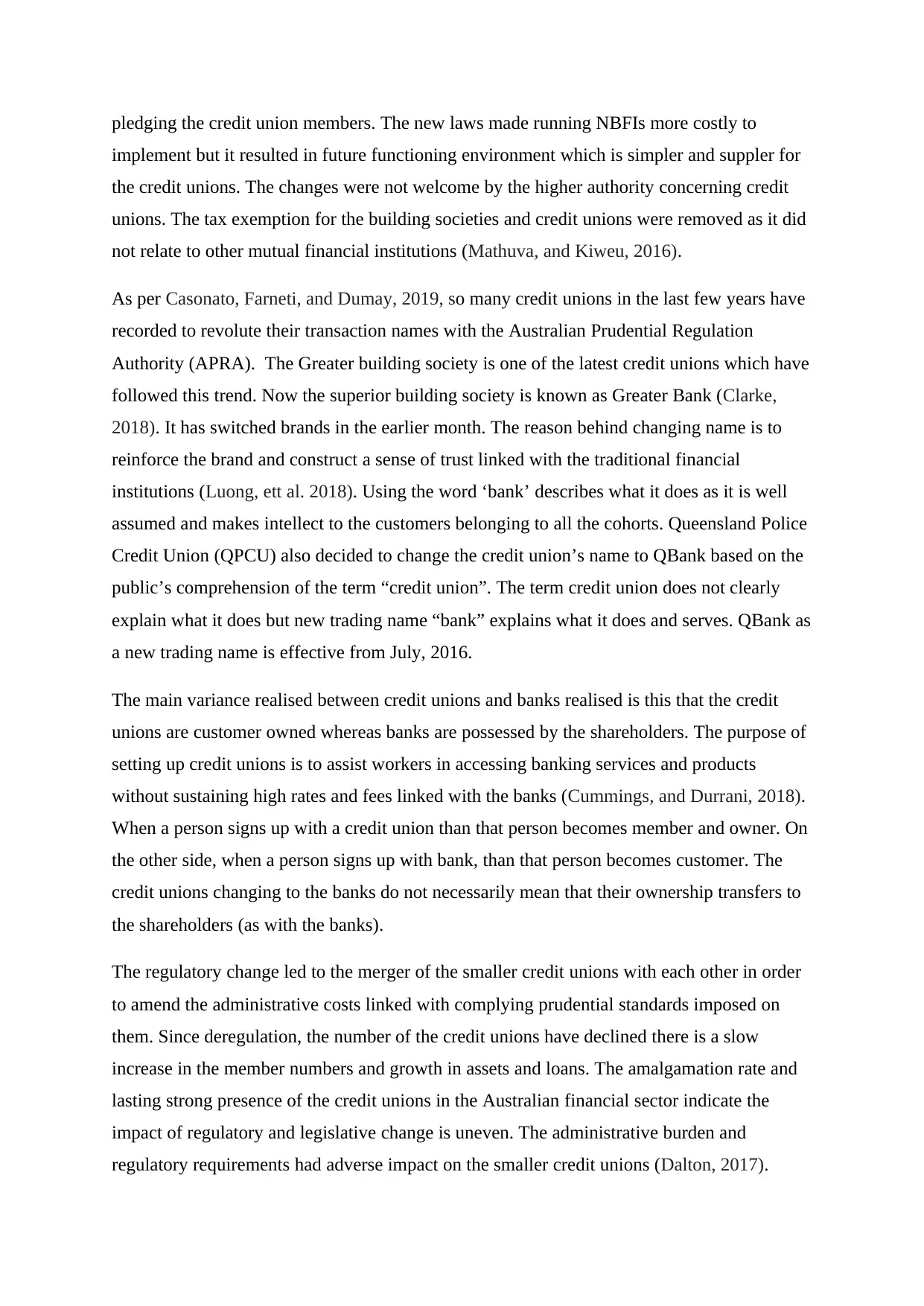
pledging the credit union members. The new laws made running NBFIs more costly to
implement but it resulted in future functioning environment which is simpler and suppler for
the credit unions. The changes were not welcome by the higher authority concerning credit
unions. The tax exemption for the building societies and credit unions were removed as it did
not relate to other mutual financial institutions (Mathuva, and Kiweu, 2016).
As per Casonato, Farneti, and Dumay, 2019, so many credit unions in the last few years have
recorded to revolute their transaction names with the Australian Prudential Regulation
Authority (APRA). The Greater building society is one of the latest credit unions which have
followed this trend. Now the superior building society is known as Greater Bank (Clarke,
2018). It has switched brands in the earlier month. The reason behind changing name is to
reinforce the brand and construct a sense of trust linked with the traditional financial
institutions (Luong, ett al. 2018). Using the word ‘bank’ describes what it does as it is well
assumed and makes intellect to the customers belonging to all the cohorts. Queensland Police
Credit Union (QPCU) also decided to change the credit union’s name to QBank based on the
public’s comprehension of the term “credit union”. The term credit union does not clearly
explain what it does but new trading name “bank” explains what it does and serves. QBank as
a new trading name is effective from July, 2016.
The main variance realised between credit unions and banks realised is this that the credit
unions are customer owned whereas banks are possessed by the shareholders. The purpose of
setting up credit unions is to assist workers in accessing banking services and products
without sustaining high rates and fees linked with the banks (Cummings, and Durrani, 2018).
When a person signs up with a credit union than that person becomes member and owner. On
the other side, when a person signs up with bank, than that person becomes customer. The
credit unions changing to the banks do not necessarily mean that their ownership transfers to
the shareholders (as with the banks).
The regulatory change led to the merger of the smaller credit unions with each other in order
to amend the administrative costs linked with complying prudential standards imposed on
them. Since deregulation, the number of the credit unions have declined there is a slow
increase in the member numbers and growth in assets and loans. The amalgamation rate and
lasting strong presence of the credit unions in the Australian financial sector indicate the
impact of regulatory and legislative change is uneven. The administrative burden and
regulatory requirements had adverse impact on the smaller credit unions (Dalton, 2017).
implement but it resulted in future functioning environment which is simpler and suppler for
the credit unions. The changes were not welcome by the higher authority concerning credit
unions. The tax exemption for the building societies and credit unions were removed as it did
not relate to other mutual financial institutions (Mathuva, and Kiweu, 2016).
As per Casonato, Farneti, and Dumay, 2019, so many credit unions in the last few years have
recorded to revolute their transaction names with the Australian Prudential Regulation
Authority (APRA). The Greater building society is one of the latest credit unions which have
followed this trend. Now the superior building society is known as Greater Bank (Clarke,
2018). It has switched brands in the earlier month. The reason behind changing name is to
reinforce the brand and construct a sense of trust linked with the traditional financial
institutions (Luong, ett al. 2018). Using the word ‘bank’ describes what it does as it is well
assumed and makes intellect to the customers belonging to all the cohorts. Queensland Police
Credit Union (QPCU) also decided to change the credit union’s name to QBank based on the
public’s comprehension of the term “credit union”. The term credit union does not clearly
explain what it does but new trading name “bank” explains what it does and serves. QBank as
a new trading name is effective from July, 2016.
The main variance realised between credit unions and banks realised is this that the credit
unions are customer owned whereas banks are possessed by the shareholders. The purpose of
setting up credit unions is to assist workers in accessing banking services and products
without sustaining high rates and fees linked with the banks (Cummings, and Durrani, 2018).
When a person signs up with a credit union than that person becomes member and owner. On
the other side, when a person signs up with bank, than that person becomes customer. The
credit unions changing to the banks do not necessarily mean that their ownership transfers to
the shareholders (as with the banks).
The regulatory change led to the merger of the smaller credit unions with each other in order
to amend the administrative costs linked with complying prudential standards imposed on
them. Since deregulation, the number of the credit unions have declined there is a slow
increase in the member numbers and growth in assets and loans. The amalgamation rate and
lasting strong presence of the credit unions in the Australian financial sector indicate the
impact of regulatory and legislative change is uneven. The administrative burden and
regulatory requirements had adverse impact on the smaller credit unions (Dalton, 2017).
Paraphrase This Document
Need a fresh take? Get an instant paraphrase of this document with our AI Paraphraser
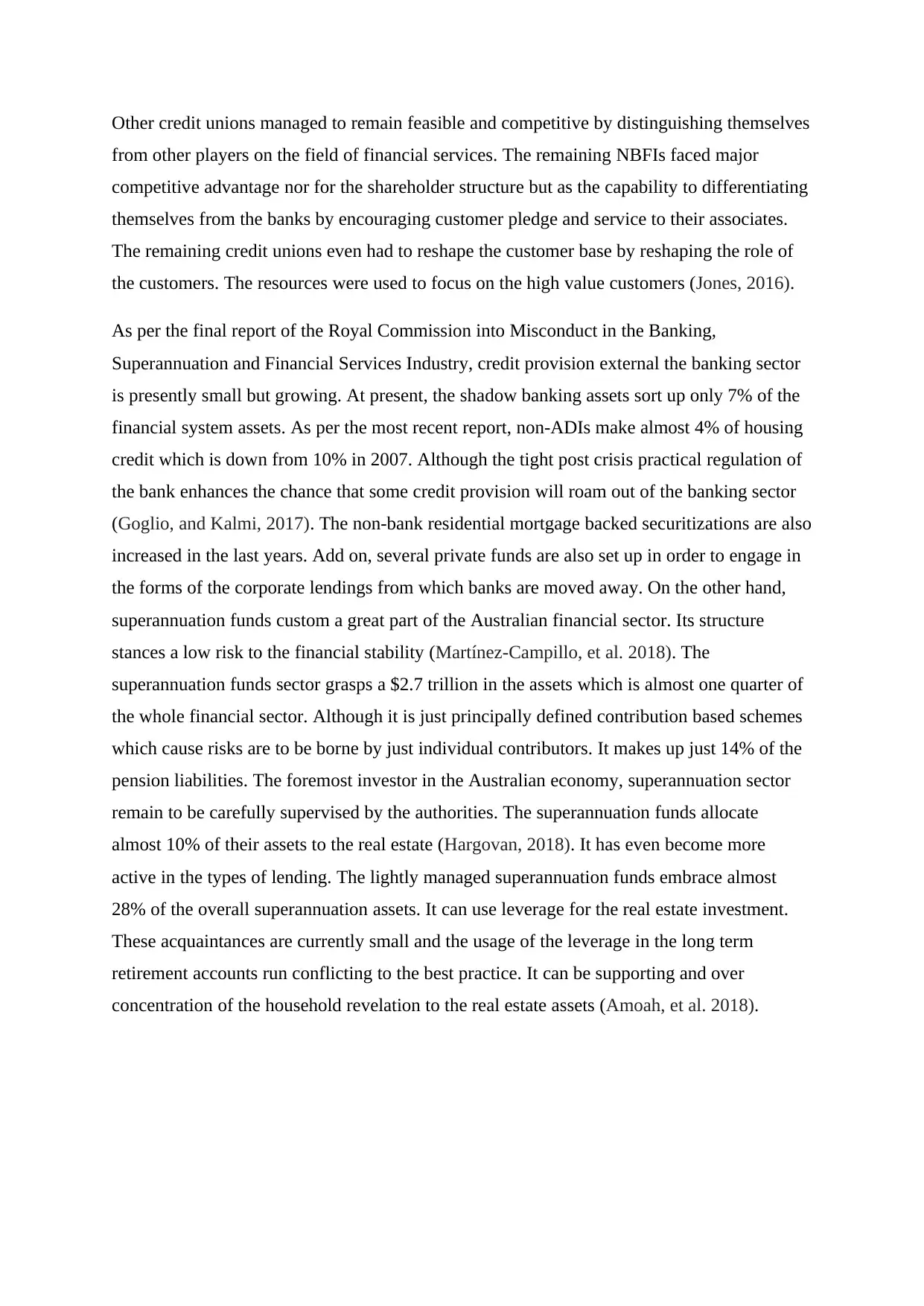
Other credit unions managed to remain feasible and competitive by distinguishing themselves
from other players on the field of financial services. The remaining NBFIs faced major
competitive advantage nor for the shareholder structure but as the capability to differentiating
themselves from the banks by encouraging customer pledge and service to their associates.
The remaining credit unions even had to reshape the customer base by reshaping the role of
the customers. The resources were used to focus on the high value customers (Jones, 2016).
As per the final report of the Royal Commission into Misconduct in the Banking,
Superannuation and Financial Services Industry, credit provision external the banking sector
is presently small but growing. At present, the shadow banking assets sort up only 7% of the
financial system assets. As per the most recent report, non-ADIs make almost 4% of housing
credit which is down from 10% in 2007. Although the tight post crisis practical regulation of
the bank enhances the chance that some credit provision will roam out of the banking sector
(Goglio, and Kalmi, 2017). The non-bank residential mortgage backed securitizations are also
increased in the last years. Add on, several private funds are also set up in order to engage in
the forms of the corporate lendings from which banks are moved away. On the other hand,
superannuation funds custom a great part of the Australian financial sector. Its structure
stances a low risk to the financial stability (Martínez-Campillo, et al. 2018). The
superannuation funds sector grasps a $2.7 trillion in the assets which is almost one quarter of
the whole financial sector. Although it is just principally defined contribution based schemes
which cause risks are to be borne by just individual contributors. It makes up just 14% of the
pension liabilities. The foremost investor in the Australian economy, superannuation sector
remain to be carefully supervised by the authorities. The superannuation funds allocate
almost 10% of their assets to the real estate (Hargovan, 2018). It has even become more
active in the types of lending. The lightly managed superannuation funds embrace almost
28% of the overall superannuation assets. It can use leverage for the real estate investment.
These acquaintances are currently small and the usage of the leverage in the long term
retirement accounts run conflicting to the best practice. It can be supporting and over
concentration of the household revelation to the real estate assets (Amoah, et al. 2018).
from other players on the field of financial services. The remaining NBFIs faced major
competitive advantage nor for the shareholder structure but as the capability to differentiating
themselves from the banks by encouraging customer pledge and service to their associates.
The remaining credit unions even had to reshape the customer base by reshaping the role of
the customers. The resources were used to focus on the high value customers (Jones, 2016).
As per the final report of the Royal Commission into Misconduct in the Banking,
Superannuation and Financial Services Industry, credit provision external the banking sector
is presently small but growing. At present, the shadow banking assets sort up only 7% of the
financial system assets. As per the most recent report, non-ADIs make almost 4% of housing
credit which is down from 10% in 2007. Although the tight post crisis practical regulation of
the bank enhances the chance that some credit provision will roam out of the banking sector
(Goglio, and Kalmi, 2017). The non-bank residential mortgage backed securitizations are also
increased in the last years. Add on, several private funds are also set up in order to engage in
the forms of the corporate lendings from which banks are moved away. On the other hand,
superannuation funds custom a great part of the Australian financial sector. Its structure
stances a low risk to the financial stability (Martínez-Campillo, et al. 2018). The
superannuation funds sector grasps a $2.7 trillion in the assets which is almost one quarter of
the whole financial sector. Although it is just principally defined contribution based schemes
which cause risks are to be borne by just individual contributors. It makes up just 14% of the
pension liabilities. The foremost investor in the Australian economy, superannuation sector
remain to be carefully supervised by the authorities. The superannuation funds allocate
almost 10% of their assets to the real estate (Hargovan, 2018). It has even become more
active in the types of lending. The lightly managed superannuation funds embrace almost
28% of the overall superannuation assets. It can use leverage for the real estate investment.
These acquaintances are currently small and the usage of the leverage in the long term
retirement accounts run conflicting to the best practice. It can be supporting and over
concentration of the household revelation to the real estate assets (Amoah, et al. 2018).
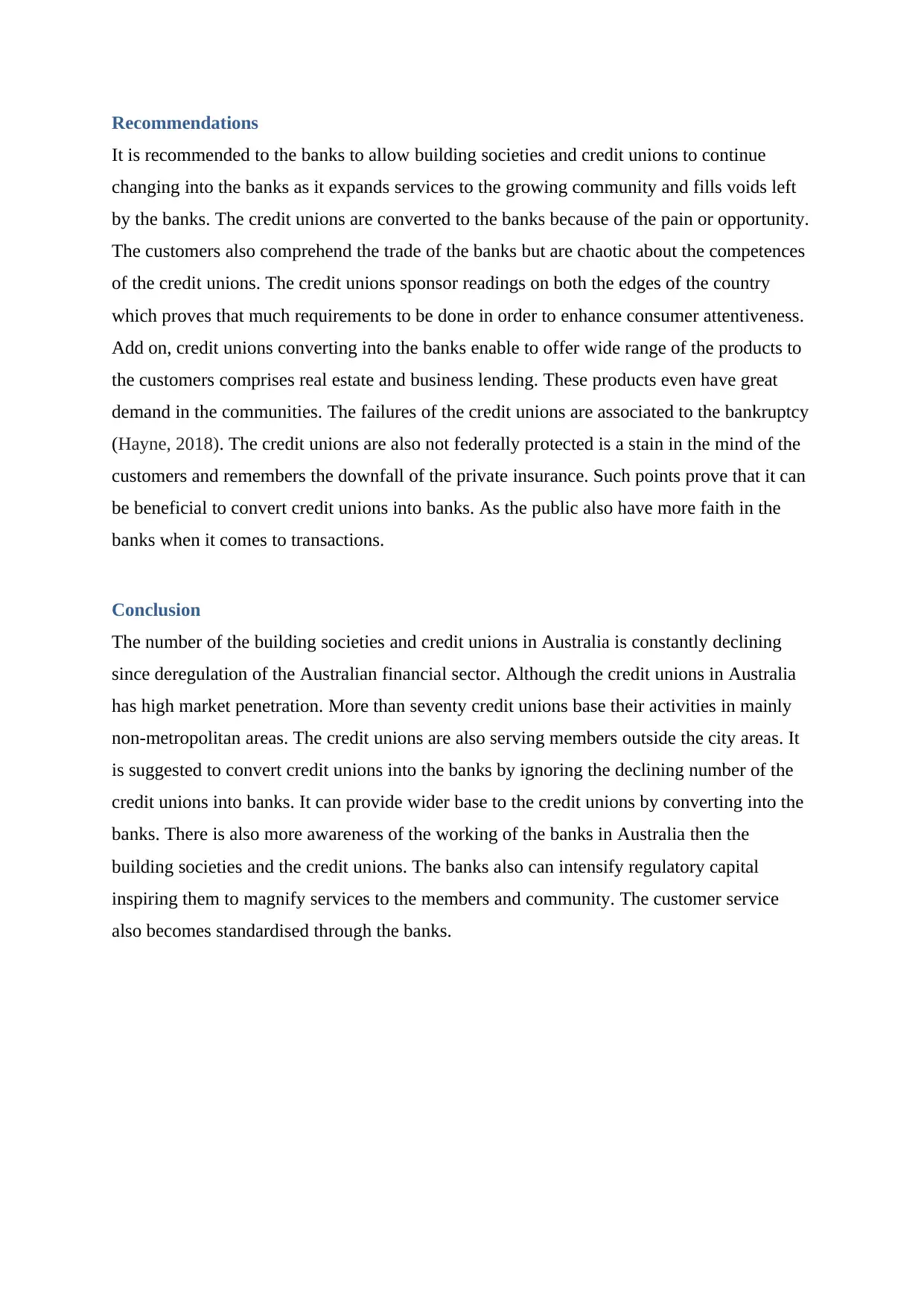
Recommendations
It is recommended to the banks to allow building societies and credit unions to continue
changing into the banks as it expands services to the growing community and fills voids left
by the banks. The credit unions are converted to the banks because of the pain or opportunity.
The customers also comprehend the trade of the banks but are chaotic about the competences
of the credit unions. The credit unions sponsor readings on both the edges of the country
which proves that much requirements to be done in order to enhance consumer attentiveness.
Add on, credit unions converting into the banks enable to offer wide range of the products to
the customers comprises real estate and business lending. These products even have great
demand in the communities. The failures of the credit unions are associated to the bankruptcy
(Hayne, 2018). The credit unions are also not federally protected is a stain in the mind of the
customers and remembers the downfall of the private insurance. Such points prove that it can
be beneficial to convert credit unions into banks. As the public also have more faith in the
banks when it comes to transactions.
Conclusion
The number of the building societies and credit unions in Australia is constantly declining
since deregulation of the Australian financial sector. Although the credit unions in Australia
has high market penetration. More than seventy credit unions base their activities in mainly
non-metropolitan areas. The credit unions are also serving members outside the city areas. It
is suggested to convert credit unions into the banks by ignoring the declining number of the
credit unions into banks. It can provide wider base to the credit unions by converting into the
banks. There is also more awareness of the working of the banks in Australia then the
building societies and the credit unions. The banks also can intensify regulatory capital
inspiring them to magnify services to the members and community. The customer service
also becomes standardised through the banks.
It is recommended to the banks to allow building societies and credit unions to continue
changing into the banks as it expands services to the growing community and fills voids left
by the banks. The credit unions are converted to the banks because of the pain or opportunity.
The customers also comprehend the trade of the banks but are chaotic about the competences
of the credit unions. The credit unions sponsor readings on both the edges of the country
which proves that much requirements to be done in order to enhance consumer attentiveness.
Add on, credit unions converting into the banks enable to offer wide range of the products to
the customers comprises real estate and business lending. These products even have great
demand in the communities. The failures of the credit unions are associated to the bankruptcy
(Hayne, 2018). The credit unions are also not federally protected is a stain in the mind of the
customers and remembers the downfall of the private insurance. Such points prove that it can
be beneficial to convert credit unions into banks. As the public also have more faith in the
banks when it comes to transactions.
Conclusion
The number of the building societies and credit unions in Australia is constantly declining
since deregulation of the Australian financial sector. Although the credit unions in Australia
has high market penetration. More than seventy credit unions base their activities in mainly
non-metropolitan areas. The credit unions are also serving members outside the city areas. It
is suggested to convert credit unions into the banks by ignoring the declining number of the
credit unions into banks. It can provide wider base to the credit unions by converting into the
banks. There is also more awareness of the working of the banks in Australia then the
building societies and the credit unions. The banks also can intensify regulatory capital
inspiring them to magnify services to the members and community. The customer service
also becomes standardised through the banks.
⊘ This is a preview!⊘
Do you want full access?
Subscribe today to unlock all pages.

Trusted by 1+ million students worldwide
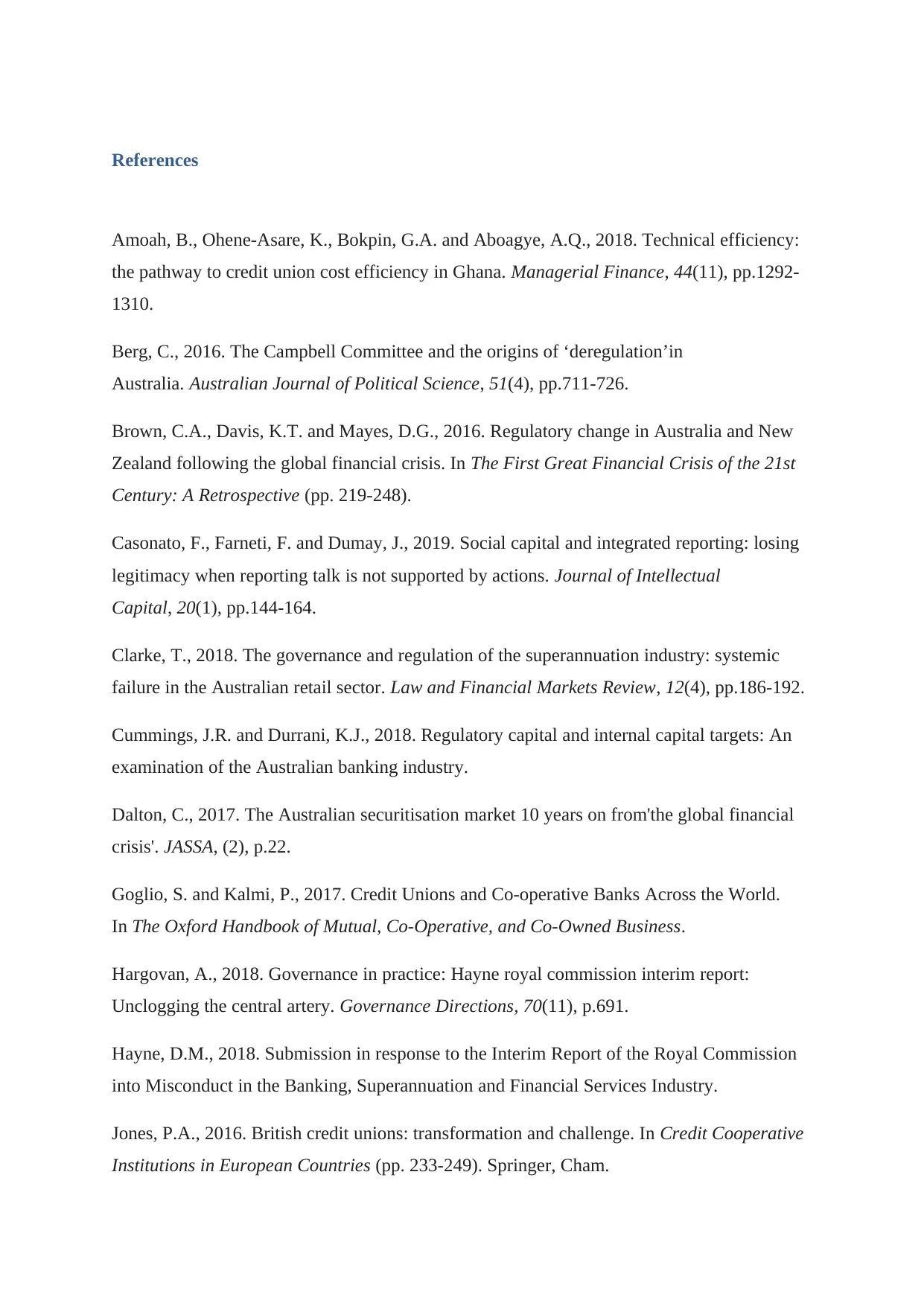
References
Amoah, B., Ohene-Asare, K., Bokpin, G.A. and Aboagye, A.Q., 2018. Technical efficiency:
the pathway to credit union cost efficiency in Ghana. Managerial Finance, 44(11), pp.1292-
1310.
Berg, C., 2016. The Campbell Committee and the origins of ‘deregulation’in
Australia. Australian Journal of Political Science, 51(4), pp.711-726.
Brown, C.A., Davis, K.T. and Mayes, D.G., 2016. Regulatory change in Australia and New
Zealand following the global financial crisis. In The First Great Financial Crisis of the 21st
Century: A Retrospective (pp. 219-248).
Casonato, F., Farneti, F. and Dumay, J., 2019. Social capital and integrated reporting: losing
legitimacy when reporting talk is not supported by actions. Journal of Intellectual
Capital, 20(1), pp.144-164.
Clarke, T., 2018. The governance and regulation of the superannuation industry: systemic
failure in the Australian retail sector. Law and Financial Markets Review, 12(4), pp.186-192.
Cummings, J.R. and Durrani, K.J., 2018. Regulatory capital and internal capital targets: An
examination of the Australian banking industry.
Dalton, C., 2017. The Australian securitisation market 10 years on from'the global financial
crisis'. JASSA, (2), p.22.
Goglio, S. and Kalmi, P., 2017. Credit Unions and Co-operative Banks Across the World.
In The Oxford Handbook of Mutual, Co-Operative, and Co-Owned Business.
Hargovan, A., 2018. Governance in practice: Hayne royal commission interim report:
Unclogging the central artery. Governance Directions, 70(11), p.691.
Hayne, D.M., 2018. Submission in response to the Interim Report of the Royal Commission
into Misconduct in the Banking, Superannuation and Financial Services Industry.
Jones, P.A., 2016. British credit unions: transformation and challenge. In Credit Cooperative
Institutions in European Countries (pp. 233-249). Springer, Cham.
Amoah, B., Ohene-Asare, K., Bokpin, G.A. and Aboagye, A.Q., 2018. Technical efficiency:
the pathway to credit union cost efficiency in Ghana. Managerial Finance, 44(11), pp.1292-
1310.
Berg, C., 2016. The Campbell Committee and the origins of ‘deregulation’in
Australia. Australian Journal of Political Science, 51(4), pp.711-726.
Brown, C.A., Davis, K.T. and Mayes, D.G., 2016. Regulatory change in Australia and New
Zealand following the global financial crisis. In The First Great Financial Crisis of the 21st
Century: A Retrospective (pp. 219-248).
Casonato, F., Farneti, F. and Dumay, J., 2019. Social capital and integrated reporting: losing
legitimacy when reporting talk is not supported by actions. Journal of Intellectual
Capital, 20(1), pp.144-164.
Clarke, T., 2018. The governance and regulation of the superannuation industry: systemic
failure in the Australian retail sector. Law and Financial Markets Review, 12(4), pp.186-192.
Cummings, J.R. and Durrani, K.J., 2018. Regulatory capital and internal capital targets: An
examination of the Australian banking industry.
Dalton, C., 2017. The Australian securitisation market 10 years on from'the global financial
crisis'. JASSA, (2), p.22.
Goglio, S. and Kalmi, P., 2017. Credit Unions and Co-operative Banks Across the World.
In The Oxford Handbook of Mutual, Co-Operative, and Co-Owned Business.
Hargovan, A., 2018. Governance in practice: Hayne royal commission interim report:
Unclogging the central artery. Governance Directions, 70(11), p.691.
Hayne, D.M., 2018. Submission in response to the Interim Report of the Royal Commission
into Misconduct in the Banking, Superannuation and Financial Services Industry.
Jones, P.A., 2016. British credit unions: transformation and challenge. In Credit Cooperative
Institutions in European Countries (pp. 233-249). Springer, Cham.
Paraphrase This Document
Need a fresh take? Get an instant paraphrase of this document with our AI Paraphraser
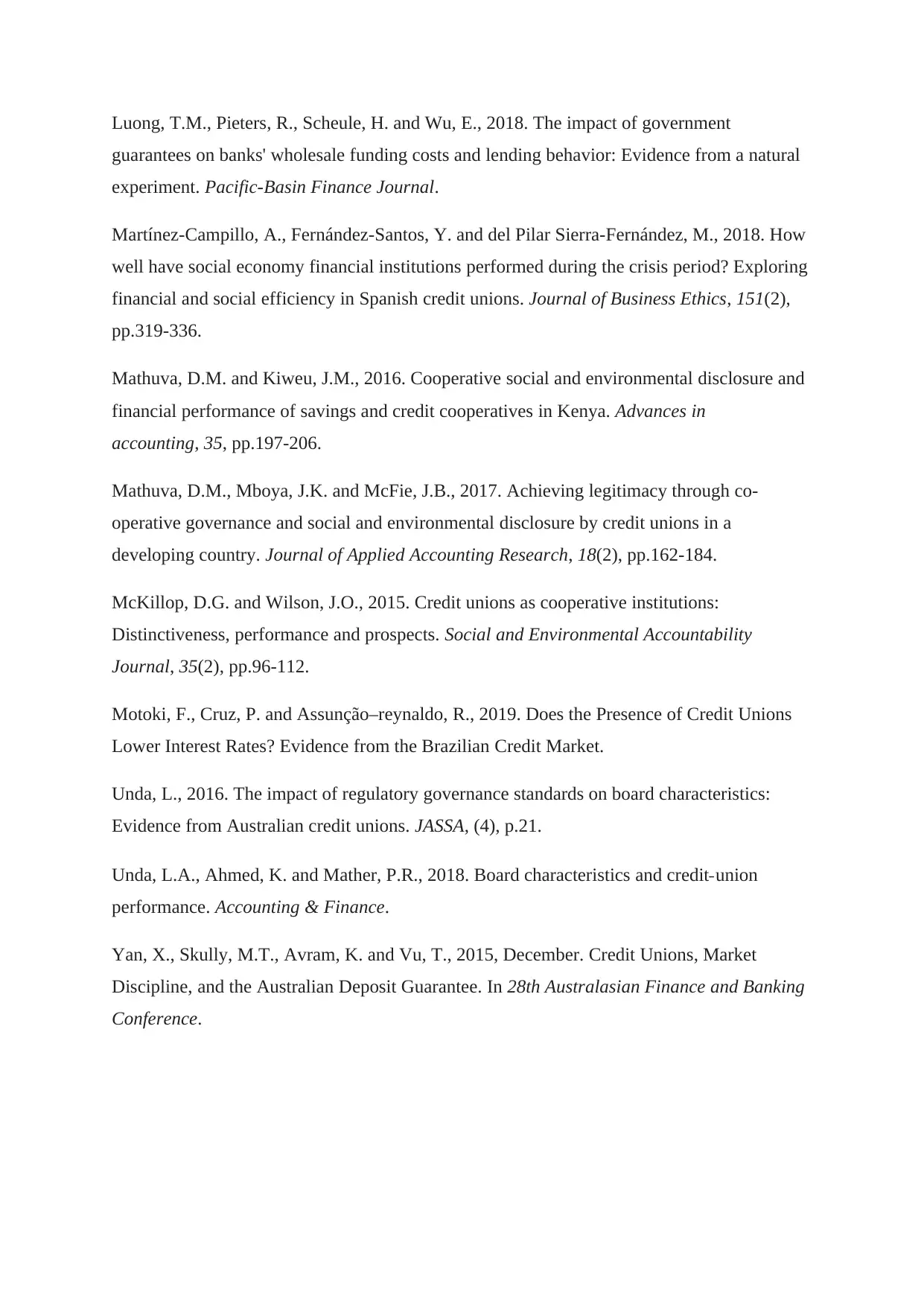
Luong, T.M., Pieters, R., Scheule, H. and Wu, E., 2018. The impact of government
guarantees on banks' wholesale funding costs and lending behavior: Evidence from a natural
experiment. Pacific-Basin Finance Journal.
Martínez-Campillo, A., Fernández-Santos, Y. and del Pilar Sierra-Fernández, M., 2018. How
well have social economy financial institutions performed during the crisis period? Exploring
financial and social efficiency in Spanish credit unions. Journal of Business Ethics, 151(2),
pp.319-336.
Mathuva, D.M. and Kiweu, J.M., 2016. Cooperative social and environmental disclosure and
financial performance of savings and credit cooperatives in Kenya. Advances in
accounting, 35, pp.197-206.
Mathuva, D.M., Mboya, J.K. and McFie, J.B., 2017. Achieving legitimacy through co-
operative governance and social and environmental disclosure by credit unions in a
developing country. Journal of Applied Accounting Research, 18(2), pp.162-184.
McKillop, D.G. and Wilson, J.O., 2015. Credit unions as cooperative institutions:
Distinctiveness, performance and prospects. Social and Environmental Accountability
Journal, 35(2), pp.96-112.
Motoki, F., Cruz, P. and Assunção–reynaldo, R., 2019. Does the Presence of Credit Unions
Lower Interest Rates? Evidence from the Brazilian Credit Market.
Unda, L., 2016. The impact of regulatory governance standards on board characteristics:
Evidence from Australian credit unions. JASSA, (4), p.21.
Unda, L.A., Ahmed, K. and Mather, P.R., 2018. Board characteristics and credit‐union
performance. Accounting & Finance.
Yan, X., Skully, M.T., Avram, K. and Vu, T., 2015, December. Credit Unions, Market
Discipline, and the Australian Deposit Guarantee. In 28th Australasian Finance and Banking
Conference.
guarantees on banks' wholesale funding costs and lending behavior: Evidence from a natural
experiment. Pacific-Basin Finance Journal.
Martínez-Campillo, A., Fernández-Santos, Y. and del Pilar Sierra-Fernández, M., 2018. How
well have social economy financial institutions performed during the crisis period? Exploring
financial and social efficiency in Spanish credit unions. Journal of Business Ethics, 151(2),
pp.319-336.
Mathuva, D.M. and Kiweu, J.M., 2016. Cooperative social and environmental disclosure and
financial performance of savings and credit cooperatives in Kenya. Advances in
accounting, 35, pp.197-206.
Mathuva, D.M., Mboya, J.K. and McFie, J.B., 2017. Achieving legitimacy through co-
operative governance and social and environmental disclosure by credit unions in a
developing country. Journal of Applied Accounting Research, 18(2), pp.162-184.
McKillop, D.G. and Wilson, J.O., 2015. Credit unions as cooperative institutions:
Distinctiveness, performance and prospects. Social and Environmental Accountability
Journal, 35(2), pp.96-112.
Motoki, F., Cruz, P. and Assunção–reynaldo, R., 2019. Does the Presence of Credit Unions
Lower Interest Rates? Evidence from the Brazilian Credit Market.
Unda, L., 2016. The impact of regulatory governance standards on board characteristics:
Evidence from Australian credit unions. JASSA, (4), p.21.
Unda, L.A., Ahmed, K. and Mather, P.R., 2018. Board characteristics and credit‐union
performance. Accounting & Finance.
Yan, X., Skully, M.T., Avram, K. and Vu, T., 2015, December. Credit Unions, Market
Discipline, and the Australian Deposit Guarantee. In 28th Australasian Finance and Banking
Conference.
1 out of 11
Related Documents
Your All-in-One AI-Powered Toolkit for Academic Success.
+13062052269
info@desklib.com
Available 24*7 on WhatsApp / Email
![[object Object]](/_next/static/media/star-bottom.7253800d.svg)
Unlock your academic potential
Copyright © 2020–2025 A2Z Services. All Rights Reserved. Developed and managed by ZUCOL.





